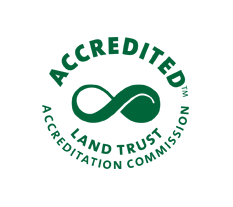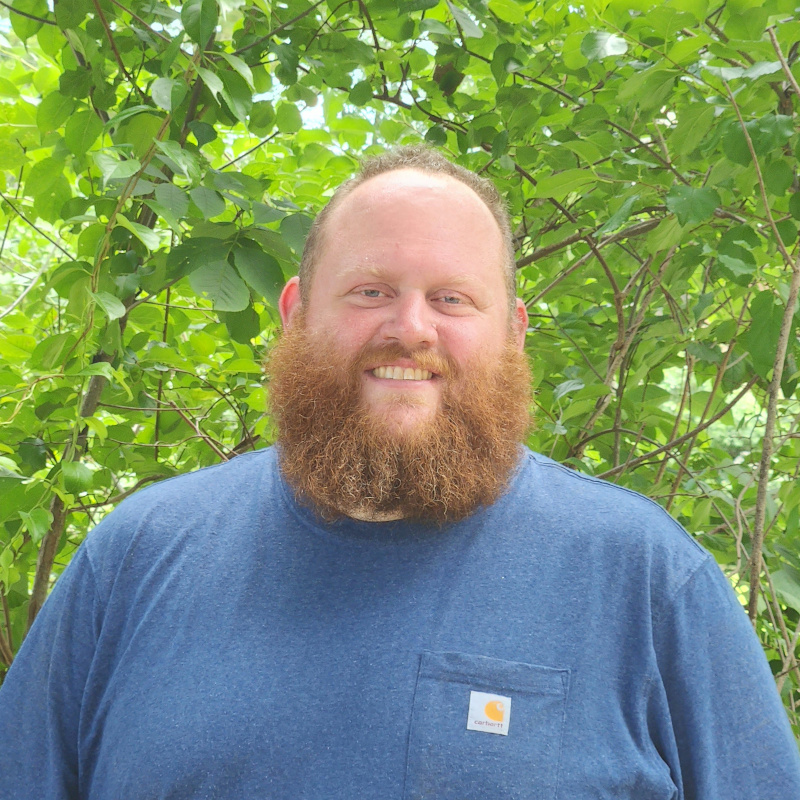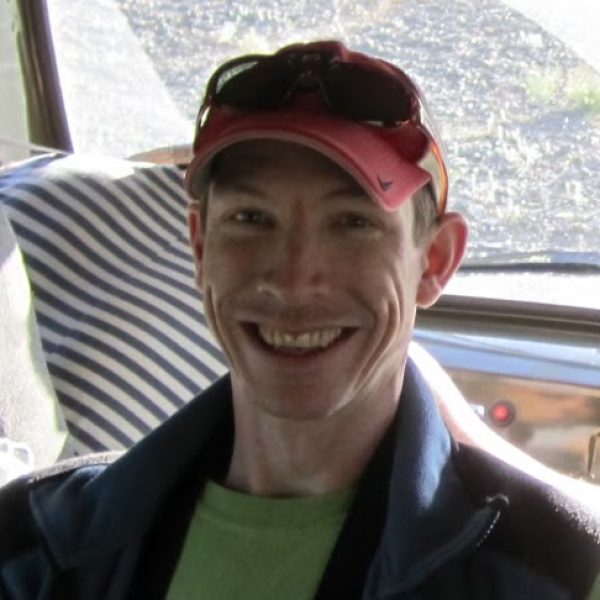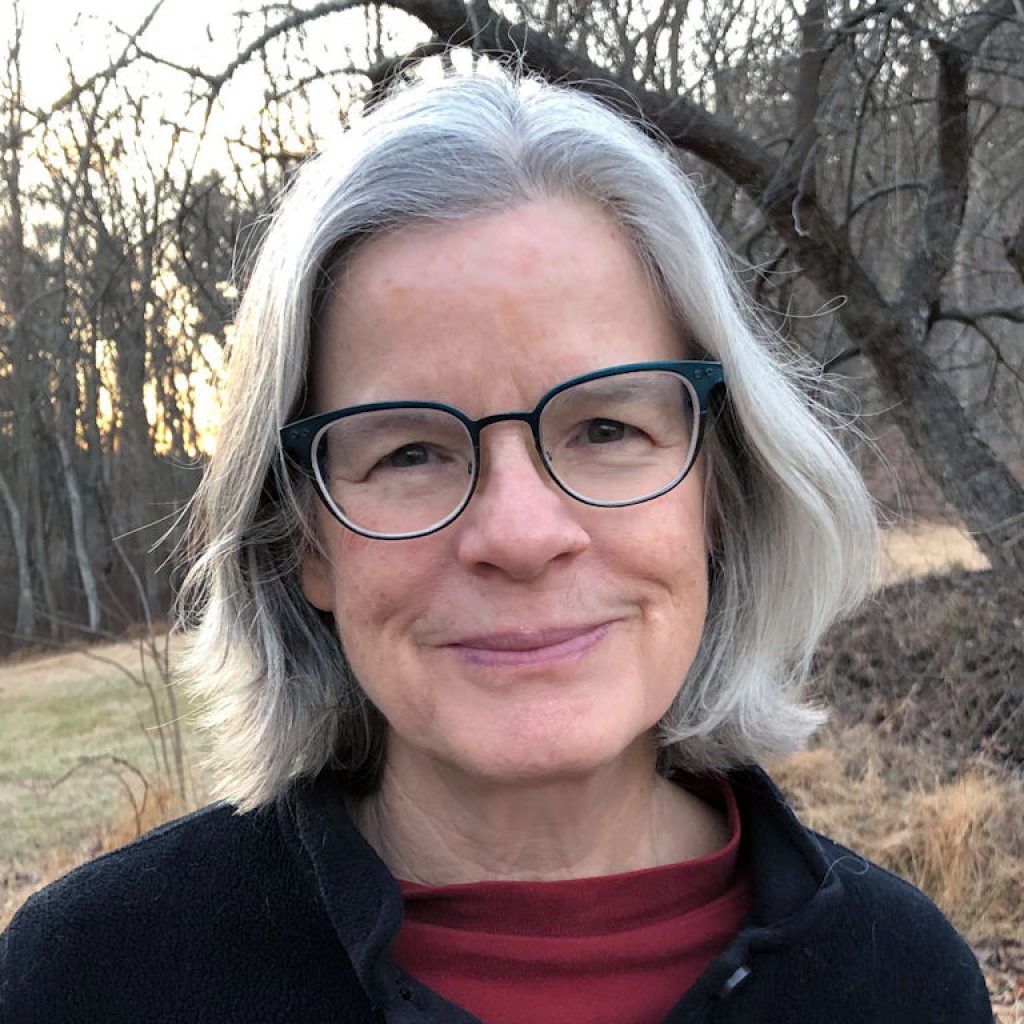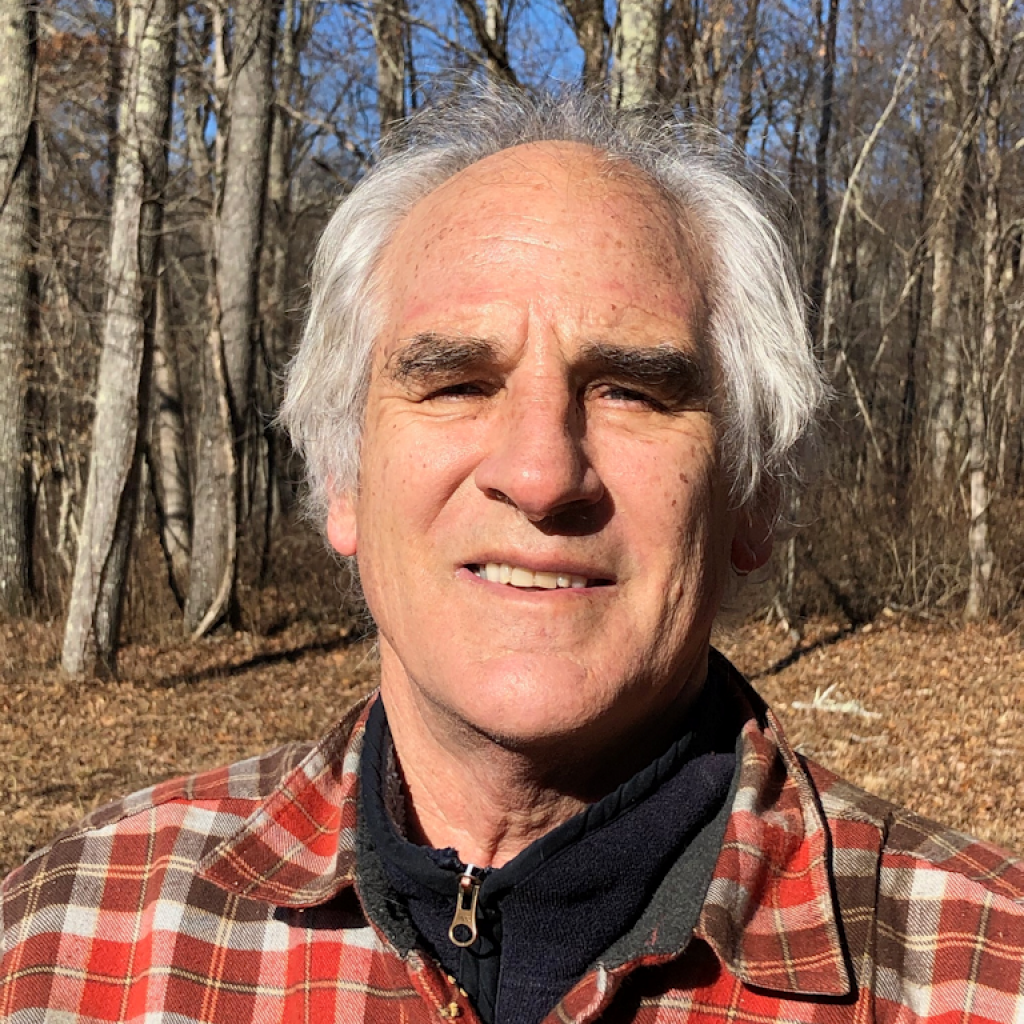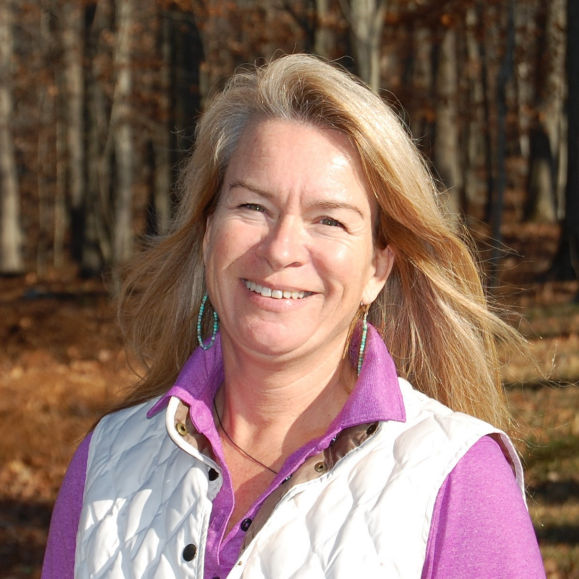•December 2010•
Hiking Trail for Public Developed on Beebe Preserve
By Don Gerber
Several days of hard work by Lyme Land Trust volunteers and staff over the summer and early autumn months has produced a new hiking trail on the Beebe Preserve, a 73 acre wooded tract near the junction of Beaverbrook, Grassy Hill and Gungy roads. (View trail map)
The one-mile trail will provide access to a number features on the Preserve – a beaver pond also visible from Beaver Brook Road, a huge stone pile left from clearing the fields in the 19th century, hundreds of feet of stone walls, stone walled sheep pens, and numerous large trees of various species.
Most of the trail is on a 64-acre parcel donated to the Land Trust in 1987 by the late William Beebe, who lived at the intersection of Beaver Brook Road, Grassy Hill Road, and Gungy Road. The donated parcel lies between Beaver Brook Road and Old Grassy Hill Road with frontage on both. A small part of the trail is on an adjacent 9 acre parcel given to the Land Trust in 1990 by Library Associates.
Preliminary layout of the trail was conducted in May. Various features were identified and visited and a preliminary trail location was flagged.
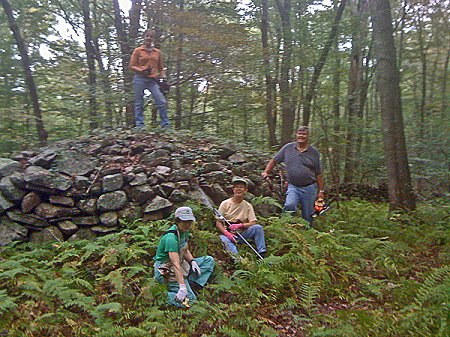
On three work days volunteers and staff have cleared and marked about three-quarters of a mile of trails. This effort includes trimming branches, clearing bull briers, breaching stone walls, removing sections of downed trees, and dropping hazardous dead trees. Also, colored trail markers are installed to assist hikers in finding their way. Another work day or two should complete the remaining quarter mile.
The parcel has about 20 feet of frontage at the town line on Old Grassy Hill Road. This area will be improved to support off-street parking for a few vehicles. The location has good sight lines and is relatively level with the road surface.
Some clearing and some surface improvement will be needed to support parking, consistent with the access points for other existing LLT trails. Finally, a sign will be constructed at the entrance to the trail. Additional work days will be scheduled to address this task.
The development of this new trail has been supported by a number of volunteers and staff – Linda Bireley, Ed Emerson, Emily Fisher, Don Gerber, Evan Griswold, Mary Guitar, and Lisa Niccolai. Additional help is needed. Work parties are normally conducted on a weekday or Saturday morning and generally last about three hours. If you would like to help, please contact Lisa Niccolai (212-3124) or Don Gerber (434-7477), and we will include you on emails when scheduling work dates.
****
Founders of the Lyme Land Trust : Shirley Howard
By George Moore
Currently living in Essex, Shirley Howard is the only remaining board member from the first annual meeting of the Lyme Land Trust on May 26, 1967.
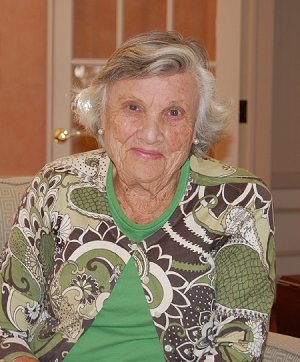 Who started the Lyme Land Trust and why was the Land Trust formed were among the questions I hoped to get answered when I went to visit her recently for an interview.
Who started the Lyme Land Trust and why was the Land Trust formed were among the questions I hoped to get answered when I went to visit her recently for an interview.
She is a very attractive, determined and intelligent lady with a fascinating recall of names and events. We weren’t far into the interview when I began to understand the Lyme Land Trust didn’t just happen.
When she lived in Lyme, she was Shirley Moore, and along with her then husband William G Moore and a few friends who shared a common vision for Lyme, she was one of the founders of the Lyme Land Trust.
Prior to moving to Lyme, she and her husband had lived in Greenwich CT and were dismayed to see the suburbanization which took place there, large parcels divided up into building lots.
They came to Lyme wanting to do what they could to prevent the same thing occurring here. Two things helped them – the rocky terrain which made development difficult and the passage of CT Public Act 490 which allowed a landowner to put acreage in excess of the zoning requirement into open space and receive considerably reduced property taxes.
While that served to slow things down, it did not prevent anyone from selling their land for development. They were aware of successful land conservation efforts in Massachusetts and wanted to set up a land trust to do the same in Lyme.
It is well known there is a “New York” community here – people who make Lyme their retirement or weekend home. Shirley related that the founders of our Land Trust not only shared a New York social and business relationship, but some were friends and neighbors in Greenwich before moving to Lyme.. Margaret “Peggy” Clucas, a land donor and long time supporter of the Land Trust who recently passed away, was William Moore’s sister and followed them to Lyme from Greenwich.
As a last illustration of the New York connection, Shirley sold her Joshua Lane house to the then Mayor John Lindsay of New York, who she said matter-of-factly “were friends of ours.”
As we went through the names of the successive presidents of the Land Trust from 1967 to 1992: Frank Stephenson , William Moore, Arthur Howe, Rufus Barringer, it was clear a group of like-minded friends guided the Trust and passed the torch for twenty-five years.
The driving force was Shirley, her husband at the time William G Moore, and their friends and neighbors Mr. & Mrs. Frank Stephenson. In 1968, both couples contributed parcels of land on either side of Rams Horn Creek – the first land ever donated to the Trust. The Moores lived on Joshua Lane, the Stephensons on Brockway’s Ferry. It was a start, almost eight acres protected. The first Land Trust president was Frank Stephenson who was followed by William Moore. Shirley served as Secretary until 1981. William Moore went on to serve as a State Senator and created and secured funding for the Gateway Commission, which has done so much to protect the first eleven miles of the Connecticut River.
Shirley said that local residents were at first resistant to the notion of affluent outsiders wanting to protect open space, but they finally came around when they realized preserving land did not adversely affect property values. Shirley bubbled with excitement when she said 60 enthusiastic people came to the first meeting brandishing letters of support and $50 checks.
Shirley stressed the New York and Greenwich immigrants had deliberately taken a low profile non-confrontational approach. They knew it would take years to convey their message and earn trust. The last thing they wanted was for people to feel they were out to acquire land. Shirley’s daughter married into the Eno family and lives in Lyme. Shirley’s roots run deep here with a daughter, a granddaughter and three great grandchildren living in Lyme.
It wasn’t until 1973 that the next land donation was made by Mrs. Orlean V Curtin who donated 20 acres on Moulson Pond. Mrs. Curtin lived in the house on Mt Archer usually referred to as the Red Mill. She was married to the world renowned architect, Edward Durell Stone.
When I told Shirley that today we are the stewards of 31 Fee and 64 Easement properties totaling well over 2500 acres – her response was “WOW! WOW!”
•November 2010•
Czikowsky Property Hike Has Big Turnout
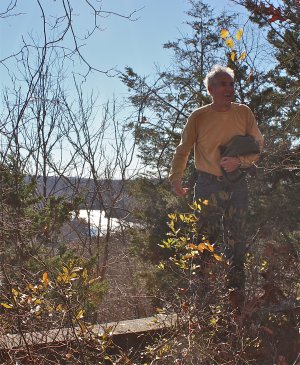
Former Lyme Land Trust President Anthony Irving led 37 hikers on Saturday Nov. 13 for the first organized walk through the newly acquired 98-acre Czikowsky property on the southern slopes of Mr. Archer.
Guided by Tony, the hikers started at the Joshuatown Road bridge over the Eightmile River, wound along the western bank of the river through a soggy flood plain, then looped back, climbing up the side of Mt. Archer to an overlook with a panorama of Hamburg Cove, the Tiffany Farm and the Sterling City area.
Along the way Tony described the flora and its various stages of development, the past use of the property, some of the history of Lyme’s agricultural evolution, and the important role that the conservation of the property plays in the protection of the Eightmile River Watershed.
The property was acquired last year by The Nature Conservancy and the Town of Lyme with the generous support of an anonymous donor. The Lyme Land Trust financially contributed to the acquisition and holds a conservation easement on the property. As part of the acquisition agreement, the Land Trust is responsible for the stewarding and maintenance of the property. There will be no marked trails on the property and access is by permission.
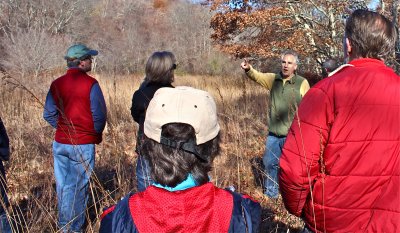
****
Local Builder Pledges 1% for Lyme Open Space
By Rich Melchreit
A local builder whose family has roots in Hadlyme going back to his great grandfather has found a unique way that his business – and others in Southeastern Connecticut – can help save open space in Lyme for future generations.
Earlier this year, Erik Block Design-Build, LLC, a well known local builder, joined an organization named “1% for the Planet,” an alliance of businesses financially committed to restoring, preserving, and protecting the environment. In doing so, the company has committed to donate one percent of its revenues generated from building projects in the town of Lyme to the Lyme Land Trust.
“One Percent” (as it is called in fund raising circles) enrolls companies doing business anywhere in world that commit to giving one percent of their gross revenues to environmental causes, and it acts as sort of a clearing house for identifying and certifying not-for-profits that can be eligible recipients of the member companies’ contributions.
Erik Block Design-Build initiated this unique relationship by contacting the Land Trust and committing to donating one percent of its gross revenues on projects in Lyme to the Land Trust if the Trust could become certified by One Percent as an eligible recipient of the Block’s donations.
The Trust applied to One Percent and was certified as an eligible recipient, creating a unique partnership between a young local builder with deep roots in Lyme and the 43-year-old Land Trust.
“When Erik suggested we join One Percent For The Planet, a worldwide alliance of conservation charities, we were curious,” said Land Trust President George Moore. “The roster of member non-profits was impressive. Money contributed by Erik Block Design & Build through this program will help support our efforts to preserve and protect open space in Lyme. It would be wonderful if more companies doing business in our town would support this marvelous fund raising concept. We applaud Erik and his colleagues for the leadership role they are taking in Lyme to preserve open space. ”
One Percent was created in 2001 by Yvon Chouinard, the founder and CEO of the legendary outfitter Patagonia, and his friend Craig Mathews, owner of Blue Ribbon Flies.
It enrolls companies from around the world that agree to give 1% of their gross revenues (yes, that’s total billings, not net profits) to environmental causes. Erik Block is the 18th of 20 builders among the 1200-plus firms enrolled to-date.
Many in Lyme and surrounding towns are familiar with Erik Block Design-Build from the ubiquitous orange “block” on a white sign in front of beautifully constructed buildings around the area. It’s a small firm founded in 2002 by young men who care about and for the environment and enjoy working with their hands and crafting with skill.
The company makes a habit of contributing to the community in many ways. Recently it built two large handsome weatherproof roadside display cases in front of Hadlyme Public Hall for promoting neighborhood events to replace old cases that had deteriorated badly over the years. Erik and his crew also replaced an exterior door at the Hall that was suffering from old age.
The Blocks take pleasure in being outside and wearing Patagonia (which makes sense when you are working outside and it is very hot or cold).
Erik Block says he has been inspired by Chouinard’s life, work and writings on how to love what you do and how to do good, not just well, while running a business.
Erik and his brother Haldan, who works with him, grew up in a fourth generation family in Hadlyme, where they spent a lot of time in the woods and where they developed a strong feeling for this special place. They say their mission is to preserve it through mutualism, not conflict, in their work creating finely crafted, sustainably built-to-last buildings.
Erik is encouraging other land trusts in southeastern Connecticut to join as well and will direct 1% of Erik Block revenues on projects in those towns to their Land Trusts.
The New London Day newspaper recently published a long article on Erik Block Design-Build, which can be accessed by clicking here.
To learn more, you can go to two handsome websites. To learn more about Erik Block Design-Build, go to www.erikblockdesignbuild.com (website designed by Haldan), and to learn more about “1% for the Planet,” go to www.onepercentfortheplanet.org.
****
State Offers $140K For Purchase of Sterling Hill Parcel
Land Trust Must Now Raise Local Share
The Lyme Land Trust has been awarded a $140,000 grant from the State of Connecticut Department of Environmental Protection (DEP) toward the $280,000 needed to preserve 40 acres on Sterling Hill Road.
“This is an important first step in our plan to acquire this parcel,” said Land Trust President George W. Moore. “It represents about half of the purchase price on which we’ve agreed with the owners. Now it’s up to us to raise the rest of the money needed with contributions from the Lyme community.”
The Land Trust will soon launch a campaign to raise the remaining $140,000, Moore said, adding that he was sure the residents of Lyme will display the same generosity and commitment to open space preservation as they have over the last 40 years.
“Lyme is one of the leaders in Connecticut in preserving open space for future generations,” he said. “Its citizens have been supporting land conservation for almost half a century, and I am sure that our efforts to raise the additional money needed for this acquisition will meet with the same success as those in the past.”
If the Land Trust can’t raise its share of the purchase price, Moore said, the money cannot be used for any other purpose, and the grant will have to be refused.
“It’s a use-it-or-lose-it challenge,” he said. “If we can’t come up with our share, the money will go to some other town.”
The parcel, which is owned by the Talcott family, is almost completely surrounded by protected land. It is adjacent to the Nehantic State Forest and the existing Emerson and Newberg easements presently held by the Land Trust.
The Nehantic State Forest abuts the parcel on the east and south, and on portions of the western side [see map]. The remainder of the western edge is bounded by a wetland already protected by an easement held by the Lyme Land Trust.
Protecting the Talcott parcel from development reduces forest fragmentation, saves wildlife habitat, complements existing land protection strategies, protects water quality in the lower Connecticut River Estuary Region, and keeps the view corridor along Rt. 156 from being marred by development on Sterling Hill.
The parcel consists of wetlands and streams, mixed oak forest, field reverting to forest, and dramatic rock ledges. The wetlands and streams that drain this property are part of the Falls Brook Watershed which feeds the nationally recognized Wild & Scenic Eightmile River at Hamburg Cove
The Land Trust applied for the grant earlier this year because it considers protection of the parcel an important piece in a quilt work of conservation land on Sterling Hill.
President Moore thanked Land Trust Vice President Temp Brown and Secretary George Lombardino for their work in shepherding the preparation of the grant application.
“They worked hard on this,” he said, but he also singled out Land Trust Project Manager Lisa Niccolai, who actually wrote the grant application. “The truth is,” he said, “much of the credit for this grant is attributable to Lisa’s grant writing skills.”
The owners would like to subdivide the property along the road but are willing to sell the rear 40-acre portion to the Land Trust.
The parcel was identified in Lyme’s 2001 Plan of Conservation and Development and by the Connecticut River Estuary Regional Planning Agency as an area that should be protected.
Acquisition of this property will allow additional passive recreation and provide a potential link to existing State Forest trails. According to the Connecticut Natural Diversity Database, State and Federal endangered species and significant natural communities are known to exist in the abutting State Forest and may potentially be found on this property.
The Sterling Hill grant, part of $10.4 million distributed statewide by the DEP for the preservation of open space, was announced by Gov. Jodi M Rell on Oct. 14 at a ceremony in East Haddam.
In announcing the grant, Gov. Rell said, “This property not only abounds with resources of its own but abuts Nehantic State Forest, meaning we will expand the size of protected space in that area.”
State Sen. Eileen M. Daily of Westbrook was also singled out by LLT President Moore for her continuing commitment to open space preservation. “Without her continual pushing in the legislature to support grant programs like this,” he said, “the funding necessary for open space acquisitions simply wouldn’t exist. We appreciate her dedication to the cause of open space preservation even in these very tough economic times.”
At the Grant Announcement – Left to right: State Sen. Eileen M Daily, State Rep. Linda A. Orange, Gov. Jodi M Rell, Land Trust President George W. Moore, and DEP Commissioner Amey Marrella at the announcement of the $140,000 challenge grant to help protect 40 acres on Sterling Hill as open space.
•October 2010•
In Memoriam Sally James Bill 1929 – 2010.
Sally James Bill, an important early leader of the Lyme Land Trust, died on Oct .15 at her home in Essex.
She was among the first members of the Land Trust and later one of its early trustees, and one of her sons and a grandson have both served as Land Trust board members.
Sally believed in serving her community. She volunteered in the school and library and served as a member of the Lyme School Board. She was a trustee of the Lyme Historical Society and an enthusiastic docent and volunteer at the Society’s Florence Griswold Museum.
She was deeply committed to the Lyme Land Trust and its mission to preserve the open space and natural beauty of Lyme for future generations. She took great joy in working with her family to permanently protect her family lands and beamed the day her grandson, Ben, became the third generation of the family to serve on the Land Trust board. Her son, Frederick “Fritz” Gahagan (Ben’s father) is currently legal counsel to the Land Trust.
Born in Bronxville, N.Y., in 1929, to Edward Lyman Bill and Dorothy James Smart, she spent most of her life at Raymond Farms in Lyme, carrying wonderful memories of four cousins and many beloved animals. Later, she shared the farm, her stupendous gardens, and her memories with her children and seven grandchildren.
Sally was a graduate of the Lincoln School in Providence. She attended Wellesley College, leaving after two years to marry Frederick G. Gahagan. She was very proud of finally completing her college education at Connecticut College at the age of 51.
Sally is survived by three of her children, Fritz Gahagan (Mary Lou Gahagan) of Lyme, Caroline Gahagan (Richard Hasner) of Pinehurst, N.C., and Lolly Gahagan (Chester Whitlock) of Newfield, N.Y.; as well as her seven grandchildren.
Contributions may be made in her memory to the Lyme Land Trust, Inc. or the Florence Griswold Museum’s Education Fund.
•September 2010•
Swallows Return to Goose Island
Sunday, September 26th
The event was a group of members, friends and neighbors who came together on a beautiful late afternoon, on an estate with a majestic view of the Connecticut River and Goose Island, with a common interest – learning about and seeing the joy of nature in all its glory. Even without having the swallows close up, and a beautiful sunset, it was a view to behold.
Susan Ballek explained to the group what we all hoped to see and why the swallows do what they do. She is a multifaceted member of the Land Trust and a wealth of information to share.
Binoculars were the appliance to have as the swallows were very far in the distance. Although the actually funnel of swallows occurred a little down river it was a fun and educational evening enjoyed by all.
BIRDS OF PREY – OWLS, HAWKS, EAGLES and FALCONS
Saturday September 11, 2010
Under sunny skies, friends of the Land Trust gathered in a field to see a spectacular presentation of SKYHUNTERS IN FLIGHT. Two shows, morning and afternoon, kept audience size small enough to allow an up close view of the birds.
The Saker Falcon
Falconer Brian Bradley brought eight birds of prey – owls, hawks, an eagle and a saker falcon and gave an informative and entertaining insight into the lives of these beautiful creatures. The birds were born in captivity and trained by him, but as he pointed out, they are still wild animals.
The Eagle Owl (aka Eurasian Owl)
We learned many things from Brian. While these predators are very good at what they do, they do not kill for sport or for fun. They kill their prey to eat and survive and in so doing help keep nature in balance. Even more interesting, they only kill and eat prey that are weak or ill.
The Saker Falcon
Children and adults marveled as first a hawk and then a young falcon flew off Brian’s arm, soared above our heads, navigated through trees on the perimeter and then dove in front of the seated guests to grab a lure. In each case a child from the audience, at a signal from Brian, ran across the field pulling the lure. They didn’t get very far before the bird dove from the sky to grab it.
Land Trust President George Moore welcomed the guests and asked them to remember the Lyme Land Trust when the Membership Renewal envelope comes in the mail. Brian Bradley, the visiting falconer, supported Moore’s message of the importance of land conservation by commenting that these creatures need protected habitat in order to survive in the skies above us.
The event was received with such enthusiasm that the Land Trust has decided to do it again on a larger scale next spring.
To see an impressive slide show of pictures taken at the event by photographer and former director Tony Sullivan, use this link: http://www.pbase.com/tonysullivan/birds_of_prey
•July 2010•
Margaret M. Clucas (1915-2010)
July 14, 2010. Margaret (Peggy) Clucas, a friend and supporter of the Lyme Land Trust passed away in her home in Lyme. In 1993 Peggy donated almost 24 acres of fields on Brush Hill Rd near Tantumorantum Rd to the Lyme Land Trust thus helping to preserve the rural feel of the area.
A memorial service will be held at 11:00am Thursday July 22, in the Lyme Congregational Church. The family has suggested donations to the Lyme Land Trust in lieu of flowers.
July 9, 2010 Courant.com
Lyme Preserves Give Imaginations A Workout
By Peter Marteka
Use this link to read a wonderful article by Hartford Courant columnist Peter Marteka about his hiking experience he had on Pickwick’s Preserve, Chauncey Eno Preserve and Mount Archer Woods. http://www.courant.com/news/opinion/courant-columnists/hc-marteka-column-0709,0,7902544.column
•June 2010•
Selectmen’s Newsletter Spring 2010 supports Land Trust Stewardship efforts:
“The Board of Selectmen wishes to express its support for the Lyme Land Trust and its on going stewardship of easements it holds for the town as a consequence of past actions by Lyme land use commissions relating to the regulatory process. In 1990, a local ordinance was enacted utilizing an enabling state statute which empowered the Conservation and Inland Wetlands Commission to hold such instruments for the town. Prior to that, the Land Trust and Nature Conservancy were the only options available for such transactions. The selectmen want to go on the record with a public statement of appreciation and support for the Land Trust and its continuing commitment to the fiduciary responsibility required to uphold the integrity of such easements.”
To read the complete newsletter go to: http://townlyme.org/newsletters-reports

